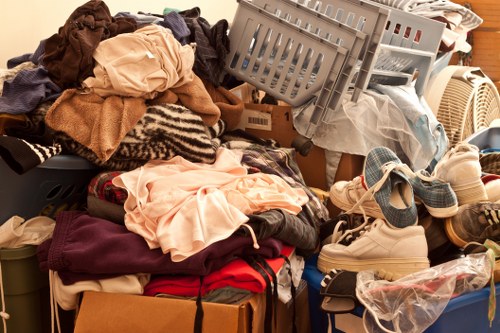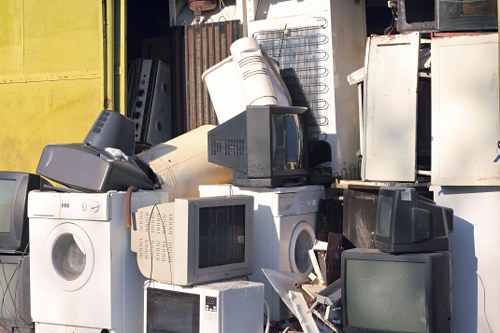Home Clearance in Council Large Item Collection
Understanding Home Clearance Services

Home clearance is an essential service for homeowners looking to declutter their spaces, especially when dealing with large items that are cumbersome to remove. Whether you're renovating, moving, or simply tidying up, council large item collection can significantly ease the process.
Large items typically include furniture, appliances, mattresses, and other bulky waste that regular waste collection services do not handle. Proper home clearance not only improves the aesthetics of your living space but also contributes to a healthier and more organized environment.
Engaging professional home clearance services ensures that your large items are disposed of responsibly, adhering to local council regulations and environmental guidelines. This prevents illegal dumping and promotes recycling and reuse of items where possible.
The Importance of Council Large Item Collection

Council large item collection plays a pivotal role in maintaining community cleanliness and environmental sustainability. By providing residents with a structured method for disposing of large waste items, councils help reduce the burden on landfill sites and encourage the recycling of materials.
Proper disposal of large items prevents potential hazards, such as blocking pathways or attracting pests, which can have adverse effects on both health and property values. Moreover, it ensures that waste is managed efficiently, minimizing the ecological footprint of residential areas.
Participating in council large item collection services also fosters a sense of community responsibility, where individuals contribute to the collective well-being by disposing of waste in an organized and environmentally friendly manner.
Steps to a Successful Home Clearance

Embarking on a home clearance project can be overwhelming, but following a structured approach can simplify the process. Here are key steps to ensure a successful clearance:
- Assessment: Begin by evaluating the items that need to be cleared. Identify which items are large and require special disposal methods.
- Planning: Schedule your clearance in advance, especially if you're coordinating with council collection services. This ensures timely removal and avoids last-minute hassles.
- Sorting: Categorize items based on their condition and disposal method. Items suitable for recycling or donation can be separated from those that need to be disposed of as waste.
- Removal: Arrange for the removal of large items through professional services or council collection days. Ensure that items are accessible and ready for pickup.
- Final Cleanup: Once the large items are removed, perform a thorough cleanup of the cleared space to restore it to its desired state.
Benefits of Professional Home Clearance Services

Opting for professional home clearance services offers numerous advantages:
- Efficiency: Professionals have the expertise and equipment to handle large items swiftly, reducing the time and effort required on your part.
- Safety: Removing bulky items can pose safety risks. Experts ensure that the process is conducted safely, minimizing potential injuries or property damage.
- Compliance: Professional services are well-versed in local council regulations, ensuring that all items are disposed of in accordance with legal guidelines.
- Environmental Responsibility: Many clearance services prioritize recycling and sustainable disposal methods, contributing to environmental conservation.
- Stress Reduction: Delegating the clearance process to professionals alleviates stress, allowing you to focus on other important tasks.
How to Schedule a Council Large Item Collection

Scheduling a council large item collection is a straightforward process that typically involves the following steps:
- Contact Your Local Council: Reach out to your local council's waste management department through their website, phone, or in-person services.
- Check Eligibility: Ensure that your items qualify for council large item collection. Most councils provide guidelines on what can and cannot be collected.
- Book a Collection: Select a convenient date and time for the collection. Some councils offer online booking systems for ease of scheduling.
- Prepare Items: Place the large items at the designated collection point, usually the curbside or a specified area in your property, on the scheduled day.
- Confirm Collection: It's advisable to confirm the collection a day prior to ensure there are no scheduling issues.
Cost Considerations for Home Clearance
Understanding the cost implications of home clearance is vital for budgeting and planning. The expenses associated with clearing large items can vary based on several factors:
- Volume of Items: The more large items you need to clear, the higher the cost due to increased labor and disposal fees.
- Type of Items: Certain items, such as electronic appliances or hazardous materials, may incur additional disposal costs.
- Service Provider: Different clearance services have varying pricing structures. It's essential to compare quotes to find a service that fits your budget.
- Accessibility: If your property has limited access, such as steep driveways or narrow pathways, it may require more time and effort, impacting the overall cost.
- Emergency Services: Last-minute or urgent clearances often come at a premium rate.
Environmental Impact of Proper Home Clearance
Proper home clearance significantly reduces the environmental impact of waste disposal. By ensuring that large items are recycled or disposed of responsibly, you contribute to the conservation of natural resources and reduction of landfill waste.
Recycling large items like furniture and appliances conserves raw materials and energy, promoting sustainability. Additionally, responsible disposal minimizes pollution by preventing hazardous substances from entering ecosystems.
Engaging in eco-friendly clearance practices aligns with broader environmental goals, fostering a healthier planet for future generations.
Choosing the Right Home Clearance Service
Selecting a reputable home clearance service is crucial for a smooth and efficient clearance experience. Consider the following factors when making your choice:
- Reputation: Look for services with positive reviews and testimonials, indicating reliability and customer satisfaction.
- Services Offered: Ensure the provider handles the types of large items you need to clear and offers additional services like recycling or donation facilitation.
- Pricing Transparency: Opt for services that provide clear and detailed pricing, avoiding hidden fees and unexpected costs.
- Availability: Choose a service that can accommodate your schedule, offering flexible booking options.
- Licensing and Insurance: Verify that the service is licensed and insured, protecting you from liability in case of accidents during the clearance process.
Legal Considerations in Large Item Disposal
Disposing of large items comes with legal responsibilities to ensure compliance with local regulations. Failure to adhere to these can result in fines or other penalties:
- Permits: Some councils require special permits for disposing of certain large items, such as asbestos-containing materials or bulky electronics.
- Restricted Items: Items like tires, batteries, and chemicals may have specific disposal guidelines. It's essential to familiarize yourself with these restrictions.
- No Unauthorized Dumping: Leaving large items on public roads or unauthorized areas is illegal and can lead to fines. Always use designated collection points or authorized services.
- Recycling Obligations: Certain regions mandate recycling of specific materials. Ensure that your clearance service complies with these requirements.
- Scheduled Collections: Adhere to the scheduled collection dates and guidelines provided by your council to avoid collection delays or penalties.
Tips for Efficient Home Clearance
Maximize the effectiveness of your home clearance with these practical tips:
- Start Early: Begin the clearance process well in advance of your moving or renovation timeline to avoid last-minute stress.
- Declutter Strategically: Tackle one room or area at a time to maintain focus and organization.
- Sort with Purpose: Use categories such as keep, donate, recycle, and dispose to streamline decision-making.
- Seek Professional Help: Don't hesitate to hire professionals for heavy lifting and transportation of large items.
- Document Valuable Items: Keep records of items donated or recycled, which can be useful for tax deductions or personal tracking.
Recycling and Donation Options
Before deciding to dispose of large items, consider recycling or donating them to extend their lifecycle and reduce waste:
- Furniture: Donate gently used furniture to charitable organizations or sell them through online marketplaces.
- Appliances: Recycle electronic appliances through specialized recycling centers or arrange for donations to communities in need.
- Mattresses: Some charities accept used mattresses, ensuring they are repurposed or recycled appropriately.
- Electronics: Recycle electronic waste to prevent hazardous materials from harming the environment.
- Books and Media: Donate books, CDs, and DVDs to libraries, schools, or second-hand stores.
Common Challenges in Home Clearance
Home clearance can present several challenges, particularly when dealing with large items. Anticipating these obstacles can help in developing effective strategies to overcome them:
- Access Issues: Narrow hallways, staircases, or limited driveway space can complicate the removal of bulky items.
- Heavy Lifting: Large items can be physically demanding to move, posing risks of injury or damage to property.
- Time Constraints: Clearing a home, especially a large one, can be time-consuming and may require careful coordination.
- Emotional Attachment: Letting go of items with sentimental value can be emotionally challenging.
- Cost Management: Balancing the need for professional services with budget limitations requires careful planning.
Maximizing Space Post-Clearance
Once the clearance is complete, it's an opportune time to reorganize and maximize your living space:
- Redesign Layout: Consider rearranging furniture to create a more open and functional environment.
- Implement Storage Solutions: Utilize storage bins, shelves, and organizers to keep remaining items tidy and accessible.
- Adopt Minimalism: Embrace a minimalist approach by keeping only essential and meaningful items, reducing clutter.
- Enhance Aesthetics: Add decorative elements like plants, artwork, or lighting to improve the visual appeal of your space.
- Maintain Cleanliness: Establish regular cleaning routines to preserve the organized and clutter-free environment achieved.
Case Studies: Successful Home Clearances
Examining real-life examples of successful home clearances can provide valuable insights and inspiration:
- Renovation Projects: Homeowners successfully cleared large items like old appliances and furniture before starting renovations, facilitating a smoother construction process.
- Moving Homes: Families efficiently managed their move by decluttering and removing unnecessary large items, reducing moving costs and simplifying the relocation process.
- Estate Cleanouts: Executors of estates managed large item clearance with the help of professional services, ensuring respectful and compliant disposal of belongings.
- Downsizing: Individuals downsizing their homes effectively cleared out large items, making the transition to smaller living spaces more manageable.
- Environmental Initiatives: Communities organized collective home clearance events, promoting environmental sustainability through shared recycling and donation efforts.
Future Trends in Home Clearance
The home clearance industry is evolving with emerging trends that enhance efficiency and sustainability:
- Digital Platforms: Online booking and tracking systems streamline the scheduling and management of home clearance services.
- Eco-Friendly Practices: Increased emphasis on recycling, upcycling, and reducing carbon footprints in clearance operations.
- Smart Waste Management: Integration of technology for better sorting, tracking, and processing of large items.
- Community Engagement: Greater collaboration with community organizations for donation and recycling initiatives.
- Personalization: Tailored clearance services that cater to the specific needs and preferences of homeowners.
Conclusion
Home clearance through council large item collection is a vital service that benefits both individuals and the community. By responsibly managing the disposal of bulky items, homeowners can maintain clean and organized living spaces while contributing to environmental sustainability.
Engaging professional clearance services ensures efficiency, safety, and compliance with local regulations, making the process seamless and stress-free. As the industry continues to evolve, embracing best practices and emerging trends will further enhance the effectiveness of home clearance initiatives.
Don't let clutter overwhelm your home. Contact us today to schedule your council large item collection and take the first step towards a cleaner, more organized living space.
